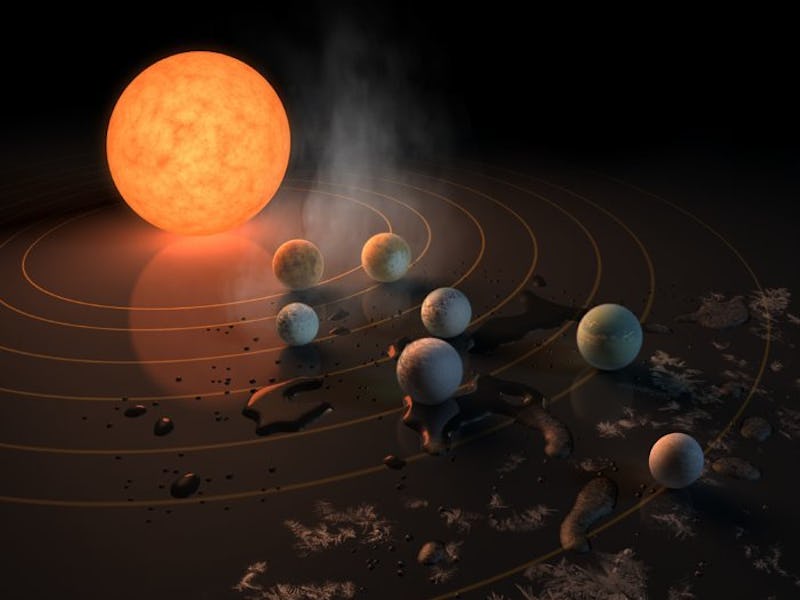The most compelling part of NASA’s long-awaited announcement on Wednesday isn’t that there are seven Earth-sized worlds revolving around the nearby star TRAPPIST-1 — it’s the fact that three of those planets are potentially habitable. In a new paper published in Nature on Wednesday, the team behind the discovery zeroes in on the three worlds in the TRAPPIST system’s “circumstellar habitable zone,” which is where we’re most likely to find extraterrestrial life, if we’re lucky.
While the seven planets are, according to a statement from lead author Michaël Gillon, an astronomer at the STAR Institute at the University of Liège in Belgium, “surprisingly similar in size to the Earth” and are all potentially water-bearing, not all of them are equally as likely to support life. Like Mercury and Venus, the three innermost planets of the newly discovered system are probably too close to their central star to support liquid water — the crucial factor of deciding a planet’s habitability — despite the fact that TRAPPIST-1 is an ultracool dwarf star that’s only 8 percent of the mass of our Sun. Fortunately, it looks like three of the remaining four planets might have the right conditions for life.
Three of these are not like the others.
The planets, in order of distance from the star, are known simply as TRAPPIST-1b, c, d, e, f, g, and h. It’s planets e, f, and g that astronomers are excited about: in an official ESO statement, they were called the “holy grail for planet-hunting astronomers” because their estimated temperature and atmospheric pressure makes it likely that they could “host oceans of surface water.”
Elaborating in their Nature paper, they outline how they came to this conclusion: They used a one-dimensional cloud-free climate model to predict what the temperature would be on planets e, f, and g, given their proximity to TRAPPIST-1, and inferred that they could “harbour water oceans on their surfaces, assuming Earth-like atmospheres.” A follow-up experiment with a three-dimensional climate model supported their findings. (The innermost planets b, c, and d, in contrast, were called “runaway greenhouses.”)
TRAPPIST-1e, f, and g are in the zone.
At a NASA press conference held Wednesday afternoon Nikole Lewis, astronomer at the Space Telescope Science Institute in Baltimore, gave a bit more detail about what these three planets are like. TRAPPIST-1-e, she said, is “very close in size to Earth, and “receives about the same amount of light as Earth does.” This planet could likely exhibit surface temperatures similar to Earth.
On the other hand, TRAPPIST-1f, which is about the same size as Earth as well, seems to have the best odds of being “a potentially water-rich world,” said Lewis.
Meanwhile, TRAPPIST-1g is the largest planet in the system, with a radius about 13 percent larger than Earth’s. It receives about the same amount of sunlight as Mars or an object in the asteroid belt.
It’s too early to say whether their assumptions about the atmospheres of these three planets are sound, but early insights into their compositions are promising. In the paper, the researchers note that the estimated mass of the six inner planets suggests that they’ve got “rocky compositions” — that is, much like the Earth or Mars, and unlike gas giants like Jupiter or Saturn. Most of their data is too imprecise to say how much of each planet is made up of volatile gases, though the low density estimated for T-1f suggests that it has a “volatile-rich composition.” The exact nature of this volatile content isn’t known yet — follow-up observations with the Hubble or the James Webb telescopes will fill in the blanks — but it’s possible, the researchers write, that it could comprise an ice layer, an atmosphere, or both. T-1f, they add, has a “stellar irradiation” similar to that of Mars, meaning that TRAPPIST-1 is likely to have had similar effects on the photochemistry of its atmosphere and potential biomarkers as the sun had on the Red Planet.
The best news, perhaps, is that the TRAPPIST system is in the nearby constellation Aquarius — we can see it from our own night sky — and is only 40 light-years away. It’s relatively close distance as far as the cosmos goes. Coupled with ESO’s new European Extremely Large Telescope and the NASA/ESA/CSA James Webb Space Telescope, the short distance will, as co-author Emmanuël Jehin said in a statement, make it possible to “search for water and perhaps even evidence of life on these worlds.”
